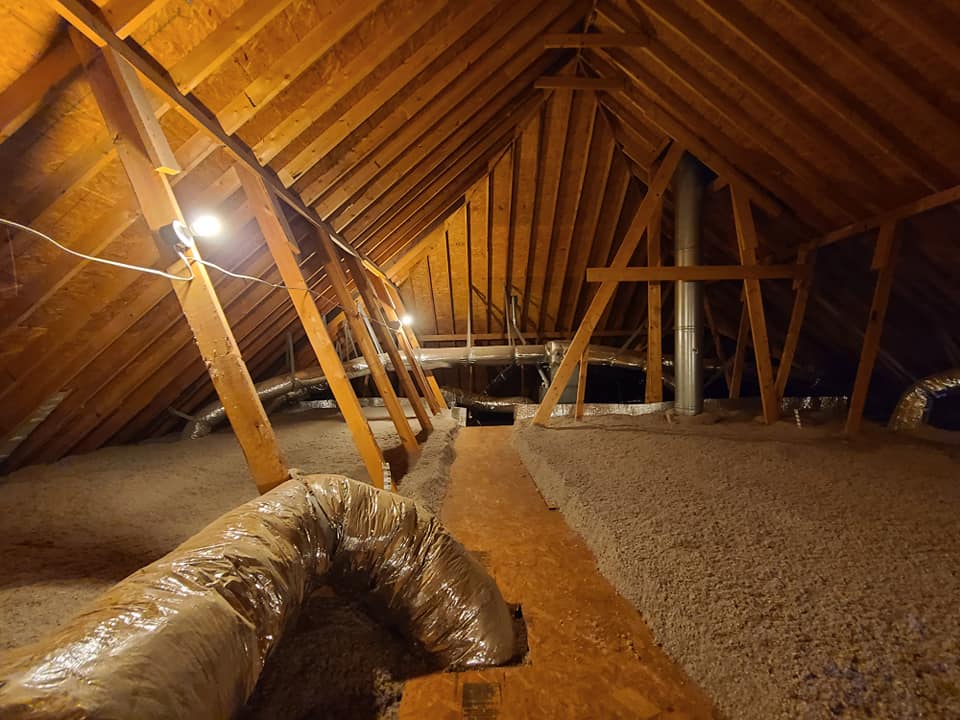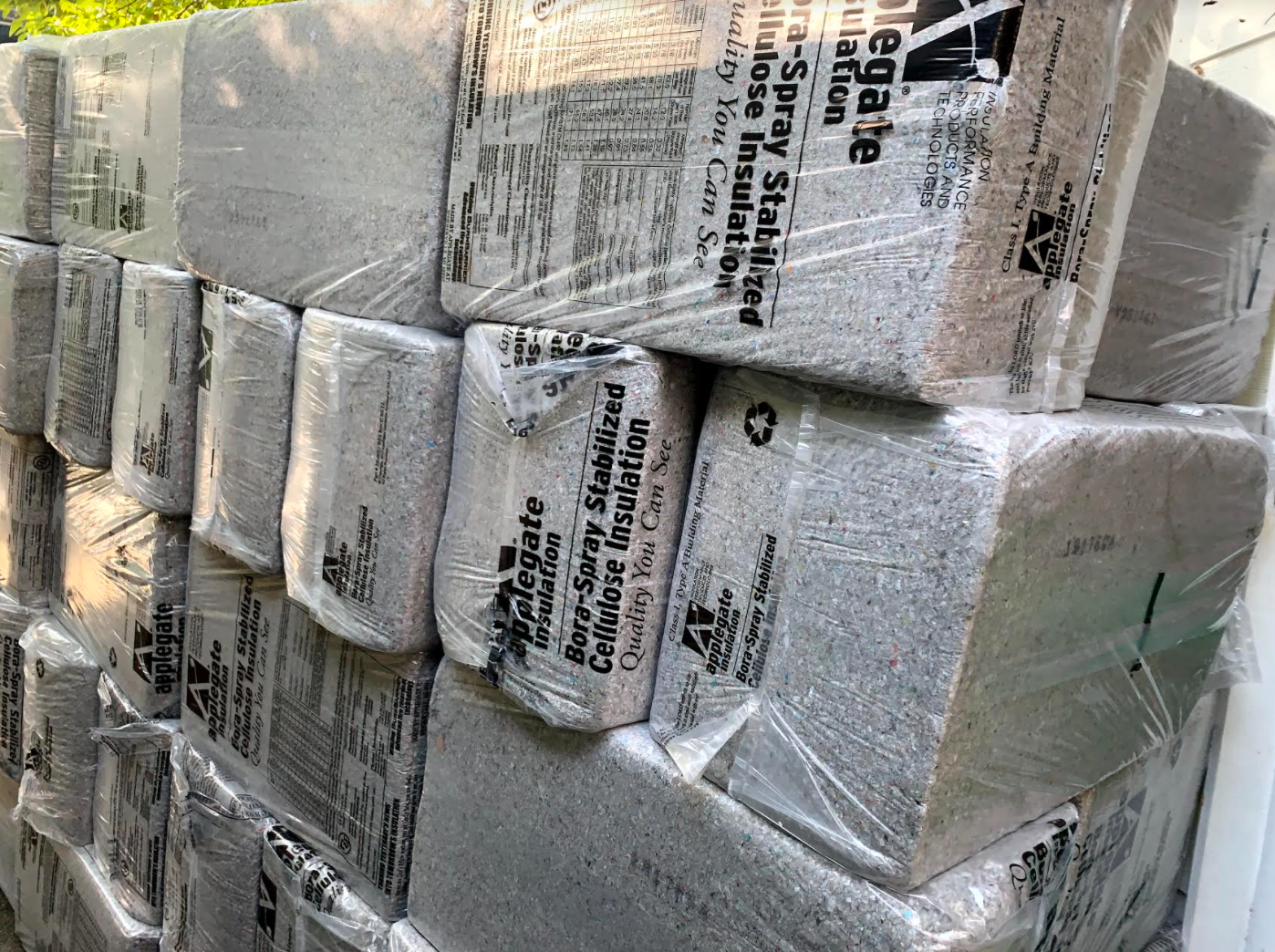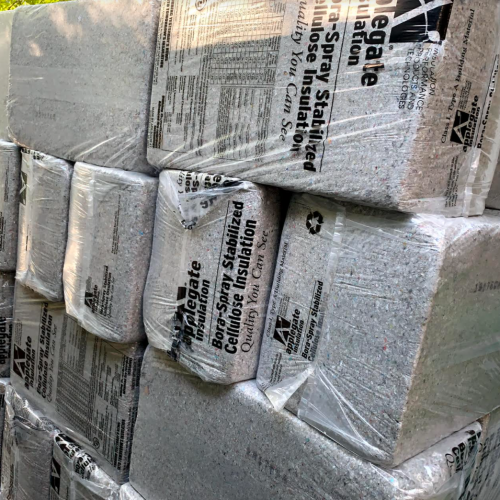We’re all aware of the difference between decaffeinated coffee and regular coffee.
Most of us know that there’s a difference between skin milk and whole milk, and regular unleaded gas and premium unleaded gas.
And for probably the majority of the population, that’s how they think of cellulose and fiberglass insulation. Not much difference between the two materials. After all, fiberglass and cellulose are both used as attic insulation and blown through a hose (loose-fill insulation) to insulate our ceilings.
Not so! In my way of thinking, the difference between cellulose and fiberglass attic insulation is as stark as the difference between gasoline and diesel fuels. Yes, gas and diesel are both fuels, they both come from petroleum, and you can buy both at the same store, but the similarities pretty much stop there.
To my knowledge, you definitely cannot run both fuels through the same engine!

Here are four major differences between fiberglass and cellulose attic insulation. To be very clear, my company, Bird Family Insulation has been installing cellulose insulation in existing homes for over twenty years. We installed cellulose insulation in our first attic in 1998! And to date, we’ve added over five million pounds of cellulose insulation mostly in the attics of Atlanta homeowners, one attic at a time.
If you sense a bias towards cellulose insulation in my writings, I can’t help it! I’m in love with cellulose insulation. Six days a week, for the greater part of every year, I enjoy conversations with homeowners about how to get their homes more comfortable, and more efficient to heat and cool, while improving their indoor air quality. Some days I feel like a phone-in radio host!
The same question, over-and-over.
And one common question seems to always surface: “Bob, what are the major differences between cellulose insulation and fiberglass insulation?”
The majority of folks I talk to don’t care. They trust that I know what’s best for them, and tell me in clear terms.
So, here are my answers to that question. I try not to use scientific jargon. Just sixth grade comprehension, where I like to live in my brain, and the level I find most homeowners enjoy speaking.
Here Are My Four Major Differences Between Fiberglass and Cellulose Attic Insulation that Every Homeowner Should Know:
Difference One: How Cellulose and Fiberglass Attic Insulation Earns Their Respective R Value
R-Value is the measurement assigned to insulation, that tells us how strongly a material resists the flow of heat. The higher the R-Value number, the stronger the material resists the flow of heat.
An aluminum kitchen pan has a very low R Value of .09, while a Yeti cup has a higher R Value!
Loosefill Cellulose attic insulation earns its R Value by blocking air flow.
Loosefill Fiberglass attic insulation earns its R Value by trapping air flow.
This is a HUGE difference. It’s a BIG deal for you as a homeowner.
Should it matter to the average homeowner how these insulation products earn their respective R-Value? Yes! Here’s why.
It’s becoming more and more obvious that sealing our homes against uncontrolled air infiltration is important. In fact, just look around and you see all new homes with double pane, gas-sealed air tight windows. House shells must be wrapped with a nylon housewrap before the exterior is finished. HVAC air ducts must be sealed and tested to prove the air tightness of the duct system.
Because cellulose attic insulation earns it’s R Value by blocking airflow, it dramatically aids in restricting uncontrolled air infiltration from trespassing back-and-forth between your unconditioned attic and your living space.
On the other hand, loose fill fiberglass attic insulation simply does very little to help restrict air movement from trespassing back-and-forth between your attic and your conditioned living space. It’s too porous!
So, in my opinion, it’s obvious that cellulose attic insulation is the better value for you.
Difference Two: Cellulose Insulation is High Density Insulation and Fiberglass Insulation is Low Density Insulation.
If your attic is currently filled with loose fill fiberglass insulation and you scooped up a huge armload of that insulation, you’d not feel much weight or mass in your arms. It’s like spun cotton candy, puffed full of zillions and zillions of air pockets.
On the other hand, if your attic contains cellulose insulation and you scooped up an armload of it, you’d immediately feel mass, or weight. This is because cellulose has a far higher density than loose fill fiberglass insulation.
And it’s that density that provides the exceptional sound deadening qualities of cellulose insulation. It’s the high density that gives cellulose the quality of blocking uncontrolled air infiltration. It’s the high density of cellulose that makes it a High Performance insulation product for your attic! Cellulose insulation gets into every nook and corner, every gap and void in your attic, and seals it against the uncontrolled movement of air. As we pile 12” to 15” (R-40 and R-50) of high performance cellulose insulation in your attic, your ceilings have a powerful, high-density thermal barrier protecting your fragile conditioned living spaces from the brutal conditions in your attic.
It’s the high density nature of cellulose insulation that makes it impossible to cheat on material. However, with low density, loose fill fiberglass insulation it’s easy to adjust the settings on the installation machines to inject more air in the hose than material, thereby puffing the fiberglass insulation. “Puffing” fiberglass insulation deceives the homeowner because the new fiberglass insulation measures higher on the rulers. However, in a few weeks after the fiberglass insulation has settled the puffed air out of it, the homeowner is left with far less actual insulation (and R Value) than he thought he was getting. Contractors who “puff” fiberglass insulation are thieves and “puffing fiberglass insulation” is a criminal act. It’s hard to catch unless you count the bags as they install your insulation, and compare the bag count with the coverage chart for your size attic.

Difference Three: Cellulose Insulation is the “Greenest of Green” Insulation Products, and Fiberglass Insulation Has a Much Lower Post Consumer Recycled Content.
If green products are important to you, you’ll love cellulose. Cellulose is simply recycled paper products. Do you see all of those red or green recycling bins for paper? The recycled paper products that you separate from your household garbage goes into recycling facilities where the paper is bound into huge bales.
The cellulose insulation manufacturers buy the big bales of post-consumer paper, and simply convert it into cellulose insulation. Your recycled paper is literally dumped into huge round drums that grind the paper into tiny bits, that are treated with a fire retardant and bundled into smaller bales to be sold to companies like Bird Family Insulation!
According to NRDC (National Resources Defense Council), cellulose insulation takes 10 times less energy to manufacture than fiberglass insulation. (Some reports claim that it takes 25–30 times less energy to manufacture cellulose than fiberglass insulation). Simply put, fiberglass insulation is produced in giant furnaces that gulp natural gas and release vast amounts of greenhouse gases into the atmosphere. These furnaces operate day and night, month after month, regardless of how much insulation is needed.
Cellulose insulation on the other hand is produced in electrically-driven mills which consume relatively little energy when operating, and no energy when shut off at day’s end!
Cellulose insulation is bought by the tractor-trailer load. A few years ago we had a load that had obviously come from the Federal Reserve. For an entire month we could see the tiny pieces of currency as we loaded the cellulose into our blowing machines!
Difference Four: There Are More Warnings on Fiberglass Insulation Packaging Than on Cellulose Insulation Packaging.
Common sense tells me that the dust from cellulose insulation is safer to breath than the microscopic glass fibers from loose fill fiberglass insulation. In fact, the Natural Resources Defence Counsel has said, “ … no adverse health effects from cellulose insulation have been identified.”
The dust from Cellulose insulation is categorized and recognized as harmless as ordinary household dust.
Perform a google search for “what does fiberglass insulation look like under a microscope”. You’ll see why you don’t want those microscopic glass fibers in your lungs and airways. Heck, nobody enjoys being tormented for days by having rubbed any unprotected skin in fiberglass insulation! If it’s happened to you, you’ll never forget the experience, and never do it again!
Millions of homeowners have fiberglass attic insulation with their (leaky) HVAC air ducts lying in the insulation, and wonder why they suffer breathing issues in their homes.
Fiberglass insulation and cellulose insulation are very popular materials used for attic insulation. However, that is where the similarity ends. Fundamentally, these two products have huge differences that impact homeowners.
It’s obvious to me that few homeowners are interested in this subject, until they’ve heard my answers. Then I hear something like, “Bob, why do they keep selling fiberglass, when they can have cellulose insulation?” It’s all about marketing, baby!

We Choose Cellulose Attic Insulation!
For my money, and for my family, we choose cellulose insulation. And I encourage everyone with a pair of ears who will listen to me, to join me. When you have a choice, there’s simply no reason to choose fiberglass attic insulation, because you can have an exceptional, outstanding experience with cellulose insulation installed in your attic!
Are you ready for an instant estimate for upgrading your attic insulation with our Applegate Bora Spray cellulose insulation?
Use our EZ online calculator where you can receive an instant estimate for our insulation services: ‘





